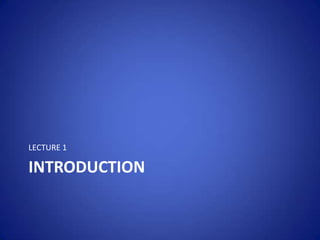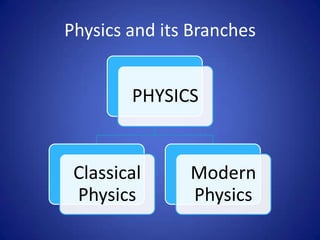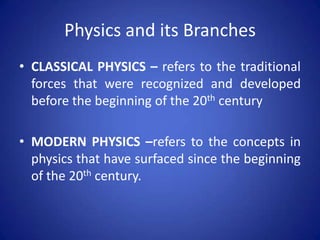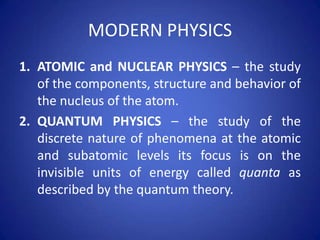Branches of Physics
- 3. PHYSICS - Is the study of everyday phenomena. It aims to explain these phenomena in terms of the fundamental laws of nature. - Is the study of matter and energy and their relationship.
- 4. Physics and its Branches PHYSICS Classical Physics Modern Physics
- 5. Physics and its Branches âĒ CLASSICAL PHYSICS â refers to the traditional forces that were recognized and developed before the beginning of the 20th century âĒ MODERN PHYSICS ârefers to the concepts in physics that have surfaced since the beginning of the 20th century.
- 6. CLASSICAL PHYSICS 1. MECHANICS â the study of forces acting on bodies whether at rest or in motion picture from: Giancoli, 2005
- 7. CLASSICAL PHYSICS 2. ACOUSTICS â The study of the production and propagation of sound waves.
- 8. CLASSICAL PHYSICS 3. OPTICS â the study of light a. PHYSICAL OPTICS â on the production, nature and properties of light b. PHYSIOLOGICAL OPTICS â on the part played by light in vision c. GEOMETRICAL OPTICS âon the reflection and refraction of light as encountered in the study of mirrors and lenses
- 10. CLASSICAL PHYSICS 4. THERMODYNAMICS â the study of the relationship between heat and other forms of energy 5. ELECTROMAGNETISM â the study of the properties of electric current and magnetism and their relationship a. ELECTROSTATICS â on electric charges at rest b. ELECTRODYNAMICS â on moving charges c. MAGNETOSTATICS â on magnetic poles at rest
- 11. MODERN PHYSICS 1. ATOMIC and NUCLEAR PHYSICS â the study of the components, structure and behavior of the nucleus of the atom. 2. QUANTUM PHYSICS â the study of the discrete nature of phenomena at the atomic and subatomic levels its focus is on the invisible units of energy called quanta as described by the quantum theory.
- 12. MODERN PHYSICS 3. RELATIVISTIC PHYSICS - the study of phenomena that take place in a forms of reference that is in motion with respect to an observer. 4. SOLID STATE PHYSICS â study of all properties of solid materials including electrical conduction in crystals of semi- conductor and metals
- 13. MODERN PHYSICS 5. CONDENSED MATTER PHYSICS âstudy of the properties of condensed materials (solids, and liquid and those intermediate between them and dense gas) with the ultimate goal and developing new material with better properties; it is an extension of solid state physics 6. PLASMA PHYSICS âthe study of the fourth state of matter; plasma
- 14. MODERN PHYSICS 7. LOW TEMPERATURE PHYSICS â the study of the production and maintenance of temperatures down to almost absolute zero and the various phenomena that occur only at such temperature.














